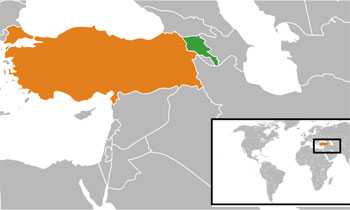Director:
Contact:
Armenian Revolt Documentary
By Jonathan Wilson Sun, 05/04/2008 – 11:26
The following is an analysis of excerpts and video scenes from the critically acclaimed Armenian Revolt Documentary, we highly recommend that you buy the DVD yourself and examine the arguments and discussions conducted in them to make up your own mind.
The Armenian Revolt DVD can be purchased for approximately $10.99 from the American Turkish Association of Houston! You may also view most of the documentary in low quality on YouTube at the bottom of this article.
In this part of the documentary of the Armenian Revolt, the background information of the Ottomans were discussed along with how Armenian society grew in the Ottoman Empire; this was an important introduction to put the Ottoman history into it’s proper context.
Contextual Background and Environment of the Ottoman Empire
Dr. Norman Stone a world renowned Ottoman historian on World War I, talked about what kind of a minority the Armenians were in the Ottoman Empire. Dr. Stone talked about the Armenians having ambassadors and even foreign ministers and other high ranking government officials in the Ottoman Empire. He also mentioned that the Armenians were known as the most loyal of Ottoman Christians, which made the Greek Christians envious of their loyalty and millet ranking
Dr. William Ochsenwald of Virginia Tech and author of “The Middle East: A History”, talked about how the religious freedoms and civil liberties granted by the Ottomans for centuries started to work against the Ottomans. The allowance of thousands of Christian missionaries to start schools, churches, and hospitals were dividing the people of the Ottoman Empire from each other. The side effect of this was the Armenian Nationalist Movement and the spread of an ideology for Armenians to rule their own nation, a Christian nation.
The documentary then introduces the Hunchaks (Hunchak Socialist Party) established in 1887 and the Dashnaks or Tashnaks (Armenian Revolutionary Federation) established in 1890, and how they were both created with an ideology to rebel against the Ottoman Empire.
Dr. Yusuf Halacoglu, president of the Turkish Historical Society, talks about how the ARF and Hunchaks were exactly like the terrorists of today, and he compares them to Al Qaeda since they both killed civilians and caused terror in the Middle East for political means.
The documentary then mentions British Ambassador Phillip Curry reported from Istanbul that the “aim of the Armenian revolutionaries is to stir disturbances, to get the Ottomans to react to violence, and thus get the foreign powers to intervene.”
Dr. Justin McCarthy of the University of Louisville, also talks about how the conflict became so intense that both sides forced all the neutral parties to pick a side, and thus the conflict became inevitable.
Dr. Sina Aksin of Ankara University, talks about the viscous cycle of revenge and violence that occurred as a result of Armenian revolts, which provoked local Muslims to seek revenge against the Armenians, not distinguishing between who is a rebel and who is an innocent Armenian. Thus more people had to choose sides and many innocent people died on both sides. Dr. Aksin tells us that for the Europeans however, the importance was the massacres of the Armenians, and the massacres of Muslims were ignored.
Dr. Mehmet Saray of Istanbul University, talks about how the local Muslims in the region felt betrayed by the Armenian revolutionist activities even though they had lived together for centuries in peace.
the unarmed Armenian villagers were forced to help the rebels at the cost of their blood.
The documentary then talks about how the Armenians were left with no choice, since the Armenian revolutionaries killed Armenians who would not help the Revolutionary cause as well.
The idea is, if a stranger attacks you and steals your money, you would be very angry, but imagine if that stranger was once your best friend? The pain is doubled, and this is what the locals felt when the Armenians they were treating equally began to attack their neighboring villages and fellow Ottoman citizens.
The Provocation Ideology of the Revolutionaries
This part of the Documentary talks about how the ARF and Hunchaks planned to provoke violence by attacking Kurdish villages and other Muslim inhabitants, who were armed and when they found their fellow tribesmen and villagers killed, they were more than prepared to strike back viciously.
The Hunchaks and ARF leaders of whom many lived in Europe, immediately received the reports which were then delivered to European diplomats, consuls, and newspapers and other publications to promote anti-Turkism and the hope that these acts of violence would compel the Europeans to defeat the Ottomans.
They conducted this method of provocation because the rebels knew that the Armenian revolutionaries themselves cannot easily overthrow the Ottomans, even though they tried several times to assassinate government leaders and governors including Sultan Abdul Hamid II.
Cast
(Credited cast)
| Professor Secil Karal Akgun | … | Herself | |
| Aram Arkun | … | Himself | |
| David Fromkin | … | Himself | |
| Professor Justin McCarthy | … | Himself | |
| Professor William Ochsenwald | … | Himself | |
| Stanford Sahw | … | Himself | |
| Norman Stone | … | Himself (as Professor Norman Stone) |


Bir yanıt yazın